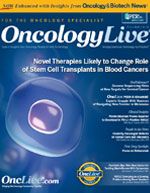Publication
Article
Oncology Live®
Genomic Classifier Refines Risk Calculation After Prostatectomy
Author(s):
Using a genomic classifier that identifies men who are at highest risk for developing metastasis after prostatectomy and salvage radiation therapy can help clinicians distinguish which patients would benefit from more aggressive follow-up therapy, according to recent research.
Robert B. Den, MD
Using a genomic classifier (GC) that identifies men who are at highest risk for developing metastasis after prostatectomy and salvage radiation therapy (SRT) can help clinicians distinguish which patients would benefit from more aggressive follow-up therapy, according to recent research.
Most men who develop elevated prostate-specific antigen (PSA) levels postprostatectomy are treated with SRT, but because PSA is an inadequate surrogate for metastatic disease, it is unclear which men may benefit from a more aggressive approach such as incorporating hormonal therapy or trying a novel agent.
“There are challenges with the management of men with prostate cancer and the current standard of practice,” said Robert B. Den, MD, assistant professor of radiation oncology and cancer biology at the Sidney Kimmel Medical College at Thomas Jefferson University in Philadelphia. “Certain patients are given treatment intensification unnecessarily, whereas others do not receive further treatment until it is too late.”
In an effort to address these challenges, Den and colleagues evaluated the Decipher Prostate Cancer Classifier, which evaluates 22 genomic markers across multiple biological pathways implicated in prostate cancer, to predict the probability of metastasis postprostatectomy. Their findings were presented during the 2015 ASTRO Annual Conference, held October 18-21, 2015, in San Antonio, Texas (Abstract 306).
Between 1990 and 2010, the researchers evaluated 166 men treated with SRT from three institutional sites: Thomas Jefferson University, Veterans Affairs Medical Center Durham, and the Mayo Clinic. The generalizability of the study was maximized by using a multi-institutional and multiethnic cohort.
“One common theme that we see in clinical trials, particularly clinical trials involving men with prostate cancer, is that certain minorities are overrepresented in the patient population, but they are underrepresented within clinical trials,” said Den. “In our study, more than 30% of the patients were African American men who tend to present with a more aggressive form of the disease.”
SRT was defined as delivering radiotherapy when PSA levels were greater than 0.2 ng/mL or by radiation following salvage androgen deprivation therapy. The primary endpoint of the study was the development of metastasis (regional or distant) as evidenced by positive computed tomography scans or bone scans.
Researchers obtained a postsurgical tissue sample from the area of each patient’s removed prostate containing the highest Gleason score. The GC and Cancer of the Prostate Risk Assessment Postsurgical (CAPRA-S) scores were compared using survival c-index, competing-risks, and Cox regression analysis for the prediction of metastasis.
A patient’s CAPRA-S scores are based on clinical risk factors such as presurgical PSA score, Gleason score, area around the prostate affected by cancer, and lymph node involvement.
“The genomic classifier is a previously published and validated test that was run on a unique set of patients in our study, so this was a new application for it,” said Den.
The GC proved to be the most significant factor in predicting metastases 5 years after SRT. The cumulative incidence of metastasis at 5 years post-SRT was 2.8%, 5.8%, and 33.5% for low, average, and high GC scores, respectively (P <.0001).
By contrast, the incidence of metastases was 17%, 2.3%, and 15% for low, average, and high CAPRA-S scores, respectively (P = .19). Additionally, the survival c-index for predicting metastasis 5 years post-SRT was 0.87 (95% CI: 0.73-0.90) for the GC and 0.62 (95% CI: 0.48-0.77) for CAPRA-S.
In univariable analysis, only the GC, extraprostatic extension, and preradiotherapy PSA were significant predictors of metastasis. In multivariable analyses with clinical risk factors or the CAPRA-S nomogram, the GC was the only independent predictor of metastasis with an HR of 1.59 (1.17-2.16, P =.0017) for a 10% unit increase in risk score.
These findings were plotted on a graph demonstrating the ratio between sensitivity and specificity. The GC area under the curve (AUC) is a prognostic factor—the higher the AUC, the higher the prognostic variable. “What this showed is that the GC has the highest AUC with a value of 0.85. This is statistically significant and higher than either two clinical nomograms that we used to compare. So the GC is not only the most significant prognostic factor but it also reflects the true underlying biology of prostate cancer,” said Den.
In terms of timing of SRT—early or late—Den said they found no significant difference in survival among patients with a low-risk GC score. “When we looked at the timing of salvage radiation therapy, patients with low GC had an excellent prognosis. On the other hand, patients with high GC are at significant risk of metastatic disease and may benefit from intensified systemic therapy,” said Den. “Patients with high-risk GC also demonstrated improved survival with early salvage RT.”
The GC biomarker can provide insight into tumor aggressiveness, said Den. “Identifying these men may allow them to undergo systemic therapy, including testing novel therapies to reduce the risk of metastases. And, the men at low risk of progression can be spared treatment intensification, such as high-dose hormone therapy, which may lead to permanent side effects.”










